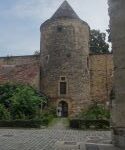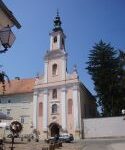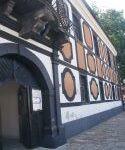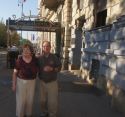July 26, 2013
Castle, Fort, Museum—3 of my favorites
Yesterday was about palaces in Zagreb. Today we took a bus tour almost to the Croatian/Slovenian border (about 50 miles from here) to visit the town of Varazdin, once the Austrian provincial capital of Croatia. Varazdin didn’t make the cut in our Lonely Planet guidebook of Eastern Europe, but it well could—for its castle and for its baroque central area. At one time it even had the largest Levis factory in the Balkans, but that’s another topic for another time.

 The central piece was to be the fort, built as part of the bulwark against Turkish incursions into the Balkans. Suleyman the Magnificent passed this way mid 16 century, and appropriately concerned Austrian rulers built the original fort, with a moat and walls to protect the area. The crown also invited many non-Croatians to settle and farm in the area to defend the realm, too; a similar story played out in most of the borderland areas. Germans were especially prone to leave the then-troubled German states in return for land in Eastern Europe; the day of reckoning tended to be 1945, when their descendants were unceremoniously ordered back to the fatherland. That made Varazdin more cosmopolitan than many other cities, and when the Turkish threat faded, the Austrians made Varazdin the first center of government in the area.
The central piece was to be the fort, built as part of the bulwark against Turkish incursions into the Balkans. Suleyman the Magnificent passed this way mid 16 century, and appropriately concerned Austrian rulers built the original fort, with a moat and walls to protect the area. The crown also invited many non-Croatians to settle and farm in the area to defend the realm, too; a similar story played out in most of the borderland areas. Germans were especially prone to leave the then-troubled German states in return for land in Eastern Europe; the day of reckoning tended to be 1945, when their descendants were unceremoniously ordered back to the fatherland. That made Varazdin more cosmopolitan than many other cities, and when the Turkish threat faded, the Austrians made Varazdin the first center of government in the area.

 Unfortunately for Varazdin, a major fire (started supposedly by a farmer who was smoking and annoyed a pig, which attacked him and sent the flame into nearby straw) destroyed the city. Austria transferred the seat of government to Zagreb, but the Varazdinians rebuilt the city—in wondrous baroque style, leaving the central business district as charming as more well-known old cities such as those along the Rhine. We had an hour
Unfortunately for Varazdin, a major fire (started supposedly by a farmer who was smoking and annoyed a pig, which attacked him and sent the flame into nearby straw) destroyed the city. Austria transferred the seat of government to Zagreb, but the Varazdinians rebuilt the city—in wondrous baroque style, leaving the central business district as charming as more well-known old cities such as those along the Rhine. We had an hour 
 to wander around the old city, which now has lots of shoppes, but few tourists; the baroque churches are especially stunning.
to wander around the old city, which now has lots of shoppes, but few tourists; the baroque churches are especially stunning.
But we had really come to see the fort; when the Turks no longer threatened, the fort became a castle, owned by a Hungarian/Croatian  family, that kept it until after World War I. Impoverished, or at least unwilling to maintain the upkeep, the family sold it to the town, when then created a museum. Hence, it was a fort, a castle, and a museum, three of my favorite places to visit! All in one place.
family, that kept it until after World War I. Impoverished, or at least unwilling to maintain the upkeep, the family sold it to the town, when then created a museum. Hence, it was a fort, a castle, and a museum, three of my favorite places to visit! All in one place.
The museum had a variety of furnished rooms, with detailed furniture from the original time period down through late 19th century Biedermeier, a German style. The weapon room had halberds, which I learned had a hook on the one side to pull armored horsemen from their horses, where, burdened by 80 pounds of armor, they were relatively helpless. One room had old guild signs, and the sign for an 18th century inn called the “Wild Man” Inn—which made me wonder….
When we got back, I got to rent a bike, finally mastering (I hope) the system of rent-a-bike that had baffled me in Paris and Berlin earlier this summer.  For about two hours I was able to cover most of the central area of Zagreb, admiring those wonderful Austrian buildings that housed the Ethnography, Arts and Crafts museums, etc—after all, I visited only 7 of the 30 museums in the city!
For about two hours I was able to cover most of the central area of Zagreb, admiring those wonderful Austrian buildings that housed the Ethnography, Arts and Crafts museums, etc—after all, I visited only 7 of the 30 museums in the city!